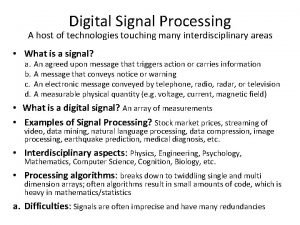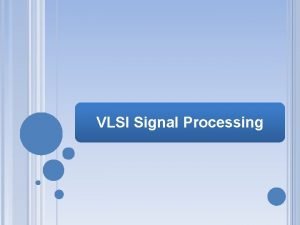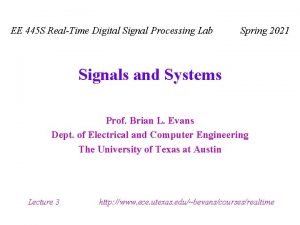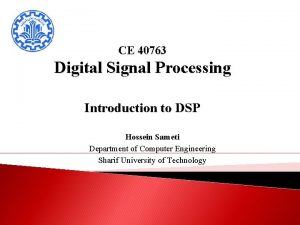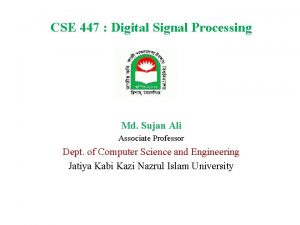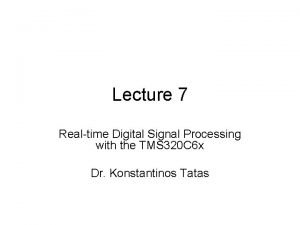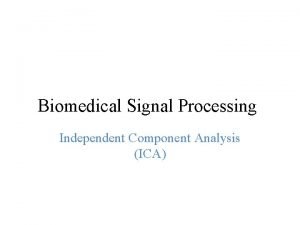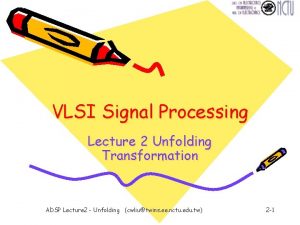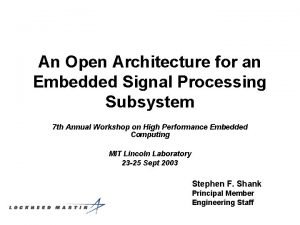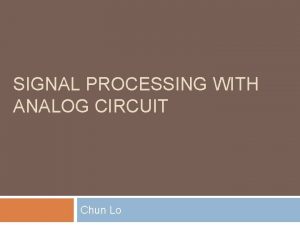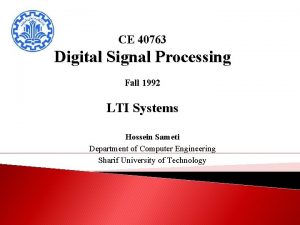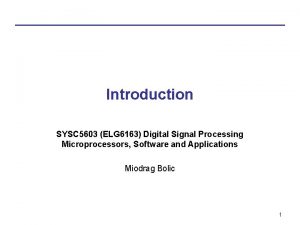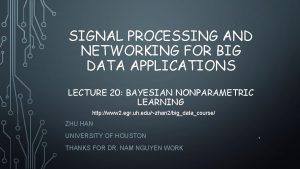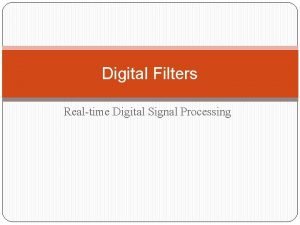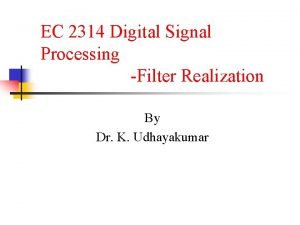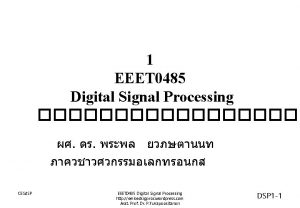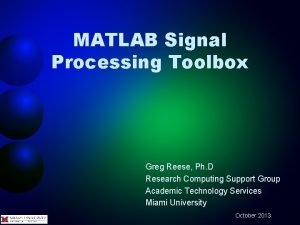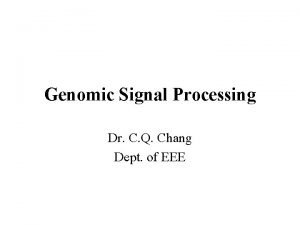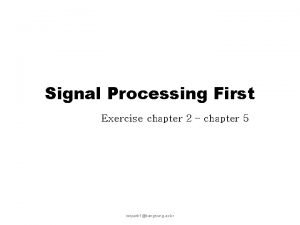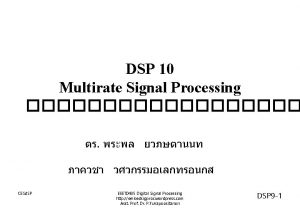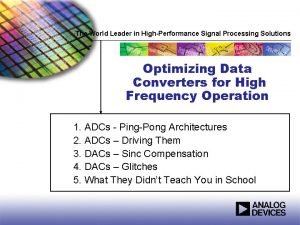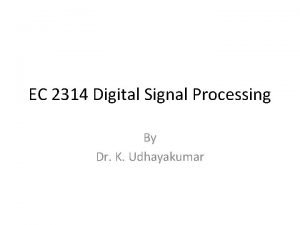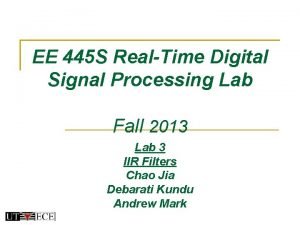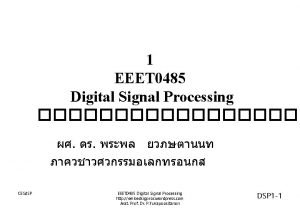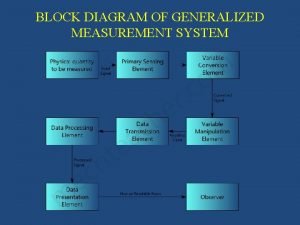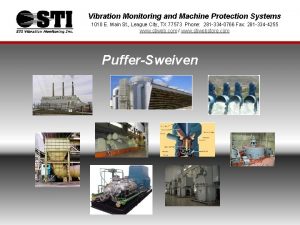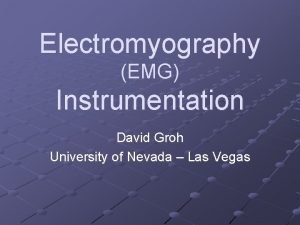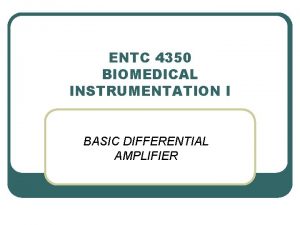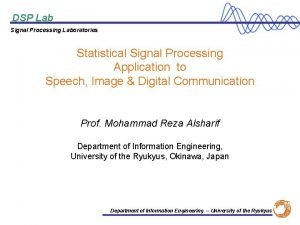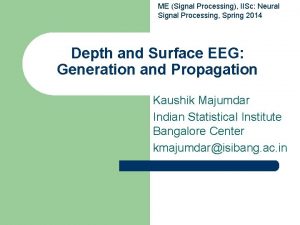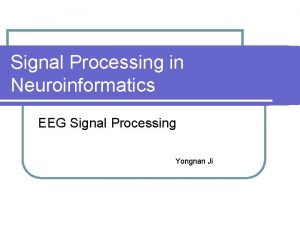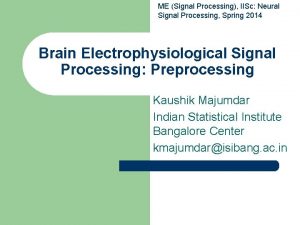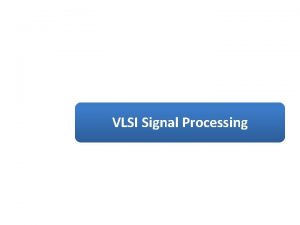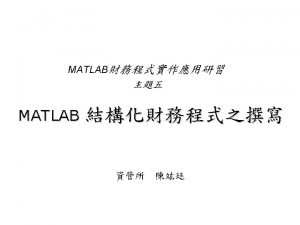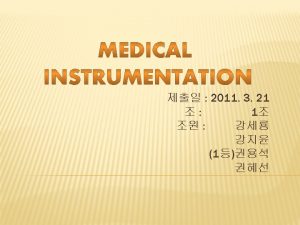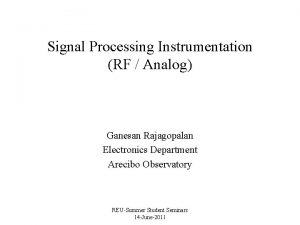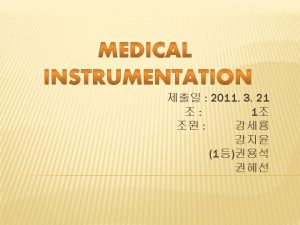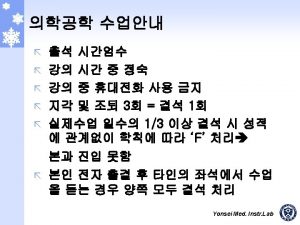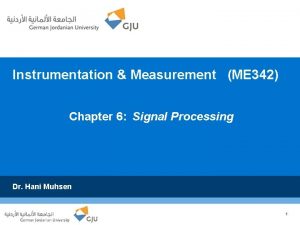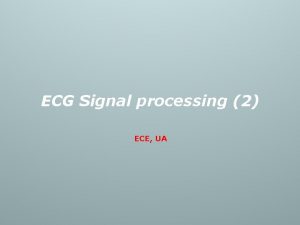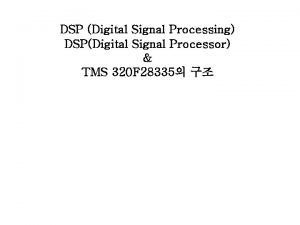NZ Aust Semiconductor Instrumentation Workshop Signal Processing Philip

















































- Slides: 49

NZ - Aust Semiconductor Instrumentation Workshop Signal Processing Philip Bones Department of Electrical & Computer Engineering University of Canterbury New Zealand Phil Bones Electrical & Computer Engineering 1

Signal Processing • • • Sampling Degradation Image recovery problems Undersampling in MRI Recently introduced tools Implementation issues and trends Phil Bones Electrical & Computer Engineering 2

Sampling Proceedings of the IEEE, 88: 569 -587, April 2000. with reference to: Shannon, C. E. “Communication in the presence of noise”, Proc. IRE, 37: 10 -21, 1949. Shannon-Whittaker-Kotel’nikov Theorem “. . . common knowledge in the communication art” Phil Bones Electrical & Computer Engineering 3

Sampling Shannon-Whittaker-Kotel’nikov Theorem: If a function f(x) contains no frequencies higher than max (in radians per second), it is completely determined by giving its ordinates at a series of points spaced T = / max seconds apart. The reconstruction formula which complements the sampling theorem is: Phil Bones Electrical & Computer Engineering 4

Reconstruction from samples In the signal domain In the frequency domain Phil Bones Electrical & Computer Engineering 5

Signal/image degradation Our ability to use the data we measure is fundamentally limited by the errors in those measurements – the “noise”. Noise has many causes; it is by its nature unpredictable and therefore best characterised statistically: • a low flux of events may best be modelled by Poisson distribution • at high fluxes, thermal effects tend to dominate Gaussian distribution Phil Bones Electrical & Computer Engineering 6

Signal/image degradation Data may also be “missing”: e. g. • there may be no direct way of making a measurement • the physics of the instrument may mean that information is lost • we cannot wait long enough to make better measurements • the medium may introduce gross distortions Phil Bones Electrical & Computer Engineering 7

Image recovery problems Conference 5562 Monday-Tuesday 2 -3 August 2004 Proceedings of SPIE Vol. 5562 Image Reconstruction from Incomplete Data III Conference Chairs: Philip J. Bones, Univ. of Canterbury (New Zealand); Michael A. Fiddy, Univ. of North Carolina/Charlotte; Rick P. Millane, Univ. of Canterbury (New Zealand) SESSION 1: Optics and Phase SESSION 2: Imaging Through Turbulence SESSION 3: Tomography SESSION 5: Regularization and Numerical Methods SESSION 6: Deconvolution SESSION 7: Inverse Problems Phil Bones Electrical & Computer Engineering 8

Image recovery problems Phil Bones Electrical & Computer Engineering 9

Example recovery problem: MRI scanner undersampling* * Blakeley, Bones, & Millane, JOSA A, 20: 67 -77, 2003. Phil Bones Electrical & Computer Engineering 10

Slice selection. . . uses pulsed excitation and z field gradient Phil Bones Electrical & Computer Engineering 11

Sampling over k-space Phil Bones Electrical & Computer Engineering 12

Motivation for undersampling • Decreasing MR acquisition time allows throughput to be increased • Alternatively, more resolution can be achieved in the same time Sampling theorem The Nyquist limit is well known (applied here in spatial frequency space): sample at the rate necessary to image the region of interest Prior knowledge The proton density can only be non-zero inside the body - the “support constraint” Phil Bones Electrical & Computer Engineering 13

Nyquist rate sampling N N y ky x DFT Dx Phil Bones kx 1/Dx Electrical & Computer Engineering 14

Undersampling in the frequency domain N’ N’ < N y ky x kx DFT Dx 1/Dx aliased image Phil Bones Electrical & Computer Engineering 15

The Problem • Reconstruction of a limited support object sampled in the frequency domain y ky FOV kx x • Where should the samples be placed? • What reconstruction algorithm should be used? Phil Bones Electrical & Computer Engineering 16

An observation • A repeated sampling pattern and iterative algorithm results in perf Phil Bones Electrical & Computer Engineering 17

Regular undersampling Þ aliased image N N y ky x Phil Bones IDFT Electrical & Computer Engineering kx 18

Division into subproblems N y y x spatial domain Phil Bones x matrix solution (9 x 9) spatial domain Electrical & Computer Engineering 19

Imposing a support constraint y y x spatial domain Phil Bones x matrix solution (9 x 6) spatial domain Electrical & Computer Engineering 20

Reconstruction Algorithm • Split the large overall problem into a number of much smaller subproblems • Solve each subproblem independently using a matrix-based direct method • Advantages: – Non-iterative – Conditioning information available – Prediction of unrecoverable regions before data acquisition Phil Bones Electrical & Computer Engineering 21

Results: direct partial recovery Phil Bones Electrical & Computer Engineering 22

Results: direct partial recovery original Phil Bones support Electrical & Computer Engineering 23

Results: direct partial recovery k-space sampling Phil Bones Electrical & Computer Engineering 24

“Universal” sampling patterns Given a support. . . y ky ? x kx . . . which pattern gives a completely recoverable image? Phil Bones Electrical & Computer Engineering 25

Universal sampling pattern y y x x matrix solution (9 x 6) ky ? Phil Bones kx Electrical & Computer Engineering 26

Universal sampling pattern y y x x matrix solution (9 x 5) ky ? Phil Bones kx Electrical & Computer Engineering 27

Universal sampling pattern y y x x matrix solution (9 x 4) ky ? Phil Bones kx Electrical & Computer Engineering 28

Finding universal patterns • 1 -D problem related to higher dimensions in certain circumstances • There are NCp possible sampling patterns – Which are universal? – Which are ‘better’? 1 • Use heuristic metrics to ensure a fast algorithm – Based on distances 2 between sample locations 3 Phil Bones Electrical & Computer Engineering 29

Result: recovery from a universal sampling pattern Phil Bones Electrical & Computer Engineering 30

Result: recovery from a universal sampling pattern Phil Bones Electrical & Computer Engineering 31

Speed of metrics-based algorithm A – a sequential search method based on linear algebraic properties B – our algorithm employing the metrics in a sequential search Time to find a pattern based on a 15 x 8 block: A 1590 sec B 0. 06 sec Note that an exhaustive search becomes impractical for N >> 20 Conclude that prior information can allow the Nyquist limit to be relaxed and useful sampling patterns can be found with a fast algorithm Phil Bones Electrical & Computer Engineering 32

Recently introduced tools • Wavelets • Neural networks • Genetic algorithms Valuable toolbox items or mainly fashion? Phil Bones Electrical & Computer Engineering 33

Wavelets Basis functions are compact in both signal and frequency spaces Extent in signal space is measured in wavelengths Both impulse-like and wave-like properties of the signal can be represented and located Both continuous (complex) and discrete forms of transform Discrete wavelet transform (DWT) is useful at isolating and locating features in an image DWT is O(N) - compare: FFT is O(N log. N) 2 -D DWT has been incorporated into JPEG 2000 Phil Bones Electrical & Computer Engineering 34

Wavelets - DWT Phil Bones Electrical & Computer Engineering 35

Wavelets Phil Bones Electrical & Computer Engineering 36

Wavelets – “denoising” Phil Bones Electrical & Computer Engineering 37

Wavelets - 2 -D DWT Phil Bones Electrical & Computer Engineering 38

Neural networks Based on ideas formulated by Mc. Culloch and Pits in the 1940 s Blossomed with the back propagation algorithm in the 1980 s Radial basis function networks and Kohonen self organising networks have since been added Useful for providing increased performance where signals are not generated by linear, stationary and Gaussian systems Phil Bones Electrical & Computer Engineering 39

Neural networks Phil Bones Electrical & Computer Engineering 40

Neural networks Phil Bones Electrical & Computer Engineering 41

Neural networks Phil Bones Electrical & Computer Engineering 42

Genetic algorithms Phil Bones Electrical & Computer Engineering 43

Genetic algorithms Phil Bones Electrical & Computer Engineering 44

Genetic algorithms Strengths - complement the conventional optimisation methods - can be made to be adaptive Weaknesses - difficult to predict performance for a GA - slow - very wide range of choices for the designer Phil Bones Electrical & Computer Engineering 45

Implementation issues and trends Industry imperatives are driven by: Multimedia - compression of image, sound, video Communications - error detection/correction coding - encryption - low power Pattern recognition - “homeland” security and personal identification - watermarking - database mining Data networks - packet processing - smart routing Phil Bones Electrical & Computer Engineering 46

Implementation issues and trends Hardware development is dominated by: DSP chips - more and more pipelining - wider and wider instructions - still based on the MAC instruction Gate arrays - DSP cores - general-purpose RISC cores Phil Bones Electrical & Computer Engineering 47

The top of Mt Aspiring (3082 m), New Zealand Phil Bones Electrical & Computer Engineering 48

just minutes from Christchurch Phil Bones Electrical & Computer Engineering 49
 Digital signal as a composite analog signal
Digital signal as a composite analog signal Product of two odd signal is
Product of two odd signal is Baseband signal and bandpass signal
Baseband signal and bandpass signal Baseband signal and bandpass signal
Baseband signal and bandpass signal Complex wave
Complex wave Parallel system tsample tclock
Parallel system tsample tclock Digital signal processing
Digital signal processing Digital signal processing
Digital signal processing High-performance digital signal processing
High-performance digital signal processing Dr sujan ali
Dr sujan ali Digital signal processing
Digital signal processing Ica signal processing
Ica signal processing Unfolding in vlsi signal processing
Unfolding in vlsi signal processing Roc in z transform
Roc in z transform Open architecture radar
Open architecture radar Precision analog signal processing
Precision analog signal processing Digital signal processing
Digital signal processing Asic form 5603
Asic form 5603 Financial signal processing
Financial signal processing Signal processing for big data
Signal processing for big data Signal processing filter
Signal processing filter Realisation structures in signal processing is for
Realisation structures in signal processing is for Image processing
Image processing Matlab signal processing toolbox
Matlab signal processing toolbox Genomic signal processing
Genomic signal processing Signal processing first
Signal processing first Digital signal processing
Digital signal processing Signal processing solutions
Signal processing solutions Types of signals
Types of signals Digital signal processing
Digital signal processing Digital signal processing
Digital signal processing Neighborhood processing in digital image processing
Neighborhood processing in digital image processing Parallel processing vs concurrent processing
Parallel processing vs concurrent processing Top down vs bottom up processing
Top down vs bottom up processing Bottom up processing
Bottom up processing What is primary processing of food
What is primary processing of food Neighborhood processing in digital image processing
Neighborhood processing in digital image processing Bottom up processing vs top down processing
Bottom up processing vs top down processing What is interactive processing
What is interactive processing Fractal image
Fractal image What is point processing in digital image processing
What is point processing in digital image processing Top-down processing vs bottom-up processing
Top-down processing vs bottom-up processing Histogram processing in digital image processing
Histogram processing in digital image processing Morphological
Morphological Instrumentation of electrophoresis
Instrumentation of electrophoresis Draw the block diagram of generalized measurement system
Draw the block diagram of generalized measurement system Machine protection systems
Machine protection systems Examples of passive instruments
Examples of passive instruments Emg instrumentation
Emg instrumentation Differential amplifier in biomedical instrumentation
Differential amplifier in biomedical instrumentation




